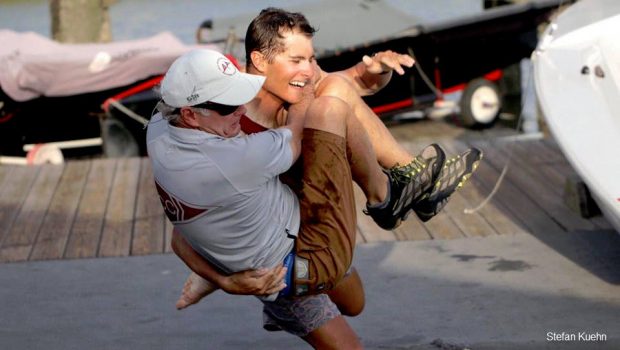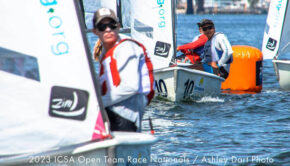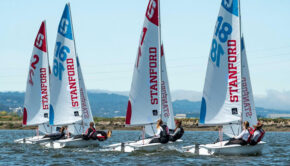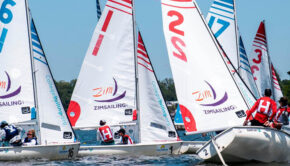How to Achieve at College Sailing
Published on August 2nd, 2017
The 2016-17 college season couldn’t have gone much better for the College of Charleston, with their successes awarding the sailing program with the Fowle Trophy, emblematic of the best overall collegiate team for the season. Scuttlebutt editor Craig Leweck checked in with Greg Fisher, Director of Sailing, for some advice and insight.
First off, congrats on the Fowle Trophy. How did that feel?
We were super stoked. There is so much depth now in college sailing, so to come out on top is an incredible achievement. We couldn’t be more proud, and what is particularly special about that trophy is how it underscores the depth of a team. From match racing to singlehanded sailing to team racing to women’s sailing to fleet racing. It is an absolute team award, from the starters to the backups that push them so hard in practice.
Now looking forward, what is your advice for the incoming freshman with high hopes to compete at the college level?
The easiest and smartest thing they can do is to get into good physical shape. The college regatta format is a long day, and it is not unusual for somebody to literally be racing flat out from 10:00 am to 4:00 or 5:00 pm. And it could be blowing 18 knots, so conditioning is critical to have the physical stamina to hang in there and keep their focus from beginning to end.
The other thing we stress is how important it is to be very confident with boat handling in an FJ and a 420 and with boat speed. This is just about being comfortable with the balance of the boat, not necessarily the intricacies of how much cunningham or outhaul, but more so knowing when the boat is going fast and when it’s not. We feel we can coach the intricacies of the game such as starting skills, boat on boat tactics, and course strategy, but the feel of making a boat go fast through the water is something we look for a sailor to bring to the college.
And your tryouts must be heart wrenching.
We have tryouts in the fall, before the season starts, and that’s become more important to us and to our incoming freshmen as we’ve grown. We’ll have upwards of 25 to 35 freshmen come to the college hoping to sail. And, unfortunately, the most we can take is perhaps 12 or maybe 15. So there are some kids that aren’t able to sail on the varsity team.
But what we started a few years ago, to accommodate the kids that don’t make the cut, is what we call our development team. We have an alum coach the team, and this group will train two days a week. If the students are hungry, this provides them with needed practice if they want to try out again the following year.
From this program we’ve taken a couple of kids back on the varsity team after they’ve worked real hard and improved a bit. So this has been a significant advancement for us to be able to offer something to everybody, so sailors that are coming into the college can have an opportunity to enjoy what our program offers.
Between training during the week and then travel for weekend regattas, having good study skills must be critical too.
Most definitely, and to help keep our students on track we have an academic advisor. This person is assigned to our team and follows our team’s grades and schedules.
For the sailors on our team, not only must they fulfill all their training and competing obligations, but they also must meet the academic advisor when they’re freshman and early sophomores, at least once a week so they know they’re on top of their studies. If the student needs any sort of assistance or guidance, the advisor is there to provide that support.
For the coaches, we get an email from the adviser once or twice a week with an update so we have a really good sense of where the team is academically. The adviser will give us a heads up if somebody needs to take some time to focus on their studies, or if they did a really great job and should be congratulated. We see this advisor as a critical element of how our team can successfully function.
You also have a keelboat program.
We sure do. Beyond the 50 or so on the dinghy team, we have another 20 on the offshore team. This program is relatively new but has really grown and gotten stronger. It’s been a huge asset for our group, because there are kids that really embrace that area of the sport. It is also an outlet for some of the kids that are too big for the dinghy boats used in college sailing.
So it’s really been a huge opportunity. They do all the big boat college regattas around the circuit and regularly sail locally with the Charleston Ocean Racing Association. They practice, just like our dinghy team does, which is three days a week plus morning work outs. They have a great time.
When your sailors graduate, it is the end of the road for what had likely been a highly focused commitment to school sailing. Any hopes and dreams for them as they go out the door?
When our team graduates and leaves the college, I hope they have as much enthusiasm for sailing– no, I hope they have more enthusiasm for sailing than when they came to Charleston and got involved with college sailing.
Sailing is such a great sport and I’d love to see them enjoy it like I have, and I want our program to have given them the abilities to purse it. Our keelboat program is doing this, as this is such a huge part of our sport. We have had our kids get involved in the Lightning class which is active in the region. We’ve started a College of Charleston Yacht Club which is fun for our alums to get together for the club challenge events throughout the country.
So we’re working hard to try to keep them engaged in the sport so that they can continue on. And when they progress with their careers and have a little extra money, hopefully the can then buy a boat or join a yacht club and carry on this passion.










 We’ll keep your information safe.
We’ll keep your information safe.